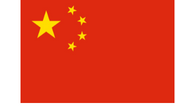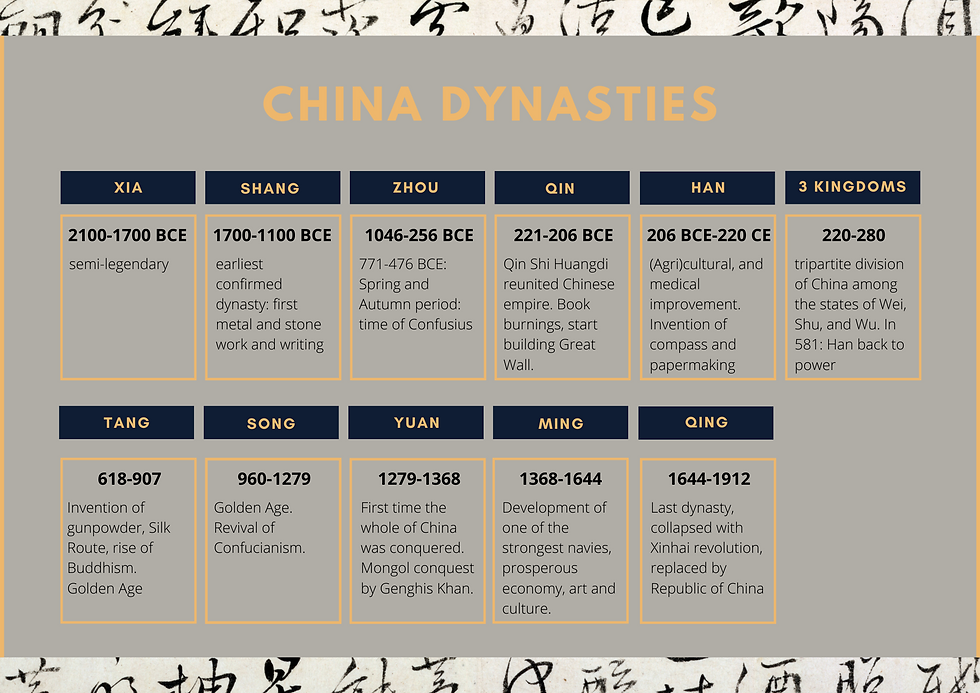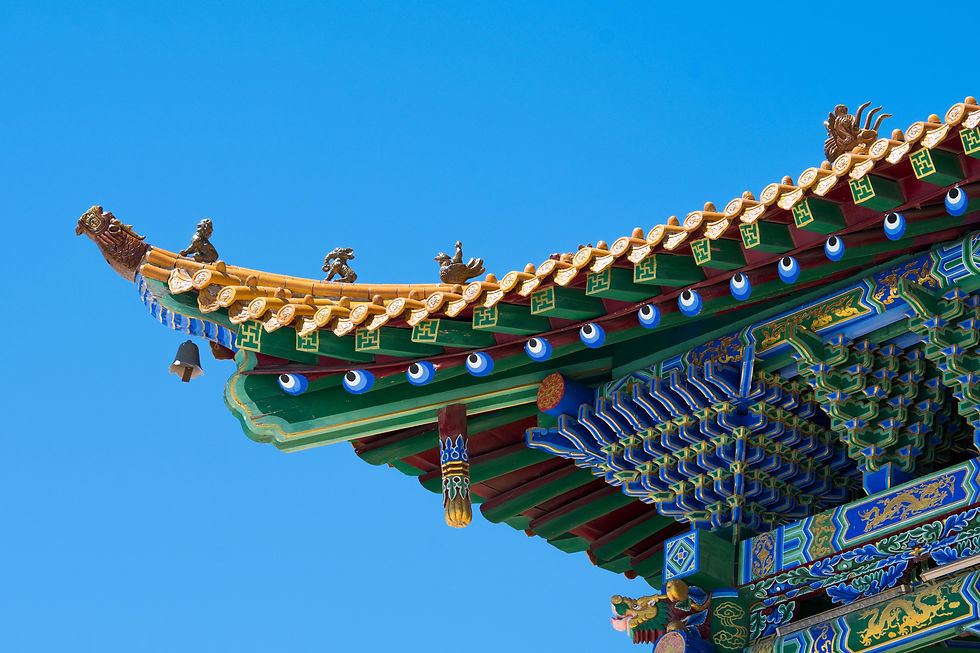The great wall, buddhism, tea, rice, Mount Everest, chopsticks, Confusius, Taoism, Jackie Chan dragons, fireworks, martial arts. Just some things that come to mind when I think of China. But also: human rights, Mao Zedong, and environmental pollution. I was excited to learn more about China, to epand my knowledge of this massive country. I think this blog will be a long one ;-).

Geological facts

Name: People's Republic of China
Capital: Beijing (Peking)
Largest city: Shanghai
Government: Unitary Marxist–Leninist one-party socialist republic
Language: Chinese
Area: 9,596,961 km2 (3,705,407 sq mi) (2nd after India)
Population: 1,411,778,724 (no 1)
Currency: Renminbi (元/¥) (CNY)
China emerged as one of the world's first civilizations in the fertile basin of the Yellow River in the North China Plain. China was one of the world's foremost economic powers for most of the two millennia from the 1st until the 19th century. For millennia, China's political system was based on absolute hereditary monarchies, or dynasties:

China was invaded by the Empire of Japan during World War II. The Civil War resulted in a division of territory in 1949 when the Communist Party (CCP) established the People's Republic of China on the mainland while the Kuomintang-led ROC government retreated to the island of Taiwan. Both claim to be the sole legitimate government of China, although the United Nations has recognized the PRC as the sole representation since 1971. China conducted a series of economic reforms since 1978, and entered into the World Trade Organization in 2001.
China is currently governed as a unitary one-party socialist republic by the Chinese Communist Party (CCP). It ranks among the lowest in international measurements of civil liberties, government transparency, freedom of the press, freedom of religion and ethnic minorities. Chinese authorities have been criticized by political dissidents and human rights activists for widespread human rights abuses. Although the accuracy of claims has been questioned by some analysts.
China is the world's largest economy by GDP at purchasing power parity and the second-largest economy by nominal GDP and the world's second wealthiest country by total wealth. The nation has a fast growing major economy, is the world's largest manufacturer and exporter and has the world's largest standing army by military personnel, with the second-largest defense budget and is an officially recognized nuclear-weapon state.
Source: Wikipedia

Interesting facts about China
China is the world's most populous country, with a population of more than 1.4 billion people.
China's famous Great Wall has a fascinating (and edible) binding material. The mortar used to bind the stones was made with sticky rice.
Fortune cookies did not originate in China (it was invented in San Francisco) and it is not a traditional Chinese custom.
If you're a runner, add the Huangyaguan Great Wall Marathon to your bucket list. It's a challenging course along the Great Wall and attracts runners from around the world.
In Chinese mythology, the dragon is the first among the four greatest creatures, along with the phoenix and tiger. This is why it is so often depicted in Chinese art and celebration.
The Bailong Elevator in Wulingyuan area of Zhangjiajie, China can carry visitors up to 300 meters high on a cliff’s edge. This elevator is the world’s heaviest and highest outdoor elevator.
Every single Panda living in the whole world belongs to China. That means if you see a Panda in your country, it is lent by China.
Ancient Chinese medicine already discovered blood 2,000 years before European scientist William Harvey announced it in 1628.
Chopsticks were originally used for cooking and not eating.
The Terracota Army in Xi’an China took 37 years to build. It consists of 8,000 clay soldiers built to guard an Emperor’s tomb. It was build by Qin Shi Huangdi.
Source: China Admissions and Wonderful Wanderings
Facts about Chinese literature
During the Han dynasty, the Five Classics were reconstructed; ancient works of wisdom that were said to have inspired Confusius. (During the Qin dynasty, the emporer ordered a mass burning of books, in an attempt to destroy every belief and story that existed before he seized power.). The Five Classics are:
A collection of 305 poems sung at sacrifices to heroes and ancestral spirits of the royal house.
A collection of documents and speeches alleged to have been written by rulers and officials of the early Zhou period and before. It is possibly the oldest Chinese narrative, and may date from the 6th century BC. It includes examples of early Chinese prose.
Describes ancient rites, social forms and court ceremonies.
The book contains a divination system comparable to Western geomancy or the West African Ifá system.
A historical record of the State of Lu, Confucius's native state, 722–481 BC.
The Classic of Music is sometimes considered the sixth classic but was lost.
Source: The Penguin Classics book and Wikipedia
Other books that are important in Chinese literature are The Four Books. These are Chinese classic texts illustrating the core value and belief systems in Confucianism. They were selected by Zhu Xi in the Song dynasty to serve as general introduction to Confucian thought, and they were, in the Ming and Qing dynasties, made the core of the official curriculum for the civil service examinations. They are:
Originally one chapter in the Book of Rites. It consists of a short main text attributed to Confucius and nine commentary chapters by Zengzi, one of the disciples of Confucius. It is significant because it expresses many themes of Chinese philosophy and political thinking, and has therefore been extremely influential both in classical and modern Chinese thought. Government, self-cultivation and investigation of things are linked.
Another chapter in Book of Rites, attributed to Confucius' grandson Zisi. The purpose of this small, 33-chapter book is to demonstrate the usefulness of a golden way to gain perfect virtue. To follow these heavenly instructions by learning and teaching will automatically result in a Confucian virtue.
A compilation of speeches by Confucius and his disciples, as well as the discussions they held.
A collection of conversations of the scholar Mencius with kings of his time. In contrast to the sayings of Confucius, which are short and self-contained, the Mencius consists of long dialogues with extensive prose.
Source: Wikipedia
Prose fiction was not traditionally a high art form, but gradually the novel established itself as a genre dureing the late Ming and early Qing dynasties with The Four Classic Novels of pre-modern Chinese literature:
Outlaws of the Marsh (a.k.a. Water Margin) by Shi Nai'an
The tragic story, set in Northern Song dynasty (around 1120), tells of how a group of 108 outlaws gather at Mount Liang (or Liangshan Marsh) to rebel against the government. Later they are granted amnesty and enlisted by the government to resist the nomadic conquest of the Liao dynasty and other rebels.
The Romance of the Three Kingdoms by Luo Guanzhong
Set in the turbulent years towards the end of the Han dynasty and the Three Kingdoms period in Chinese history, starting in 169 AD and ending with the reunification of the land in 280 by Western Jin. The story – part historical, part legend, and part mythical – romanticises and dramatises the lives of feudal lords and their retainers, who tried to replace the dwindling Han dynasty or restore it.
Monkey (a.k.a. Journey to the West) by Wu Cheng'en
The novel is an extended account of the legendary pilgrimage of the Tang dynasty Buddhist monk Xuanzang, who travelled to the "Western Regions" (Central Asia and the Indian subcontinent) to obtain Buddhist sacred texts (sūtras) and returned after many trials and much suffering.
The Story of the Stone (a.k.a. The Dream of the Red Chamber), 5 parts by Cao Xueqin
It is a masterpiece of Chinese literature, known for its psychological scope, and its observation of the world view, aesthetics, life-styles, and social relations of 18th-century China. The intricate strands of its plot depict the rise and decline of a family much like Cao’s own and, by extension, of the dynasty itself.
The book I read

Half of Man is Woman by X.L. Zhang
Translator: Rint Sybesma
Synopsis: Poet Zhang Yonglin is sentenced to a labor camp he ironically describes as a haven amidst the hysteria of the Chinese Cultural Revolution. After he marries a woman he had seen eight years earlier, the story becomes, on one level, an analogy between his temporary sexual impotence and the position of intellectuals. A year later he is ready to abandon his wife and escape from the camp. Cameo appearances by philosophic and literary figures (Marx and Meng-tz, Othello and Song Ji) and discussing China and sex allow the incorporation of non-novelistic elements while indulging in gallows humor.
This book was well written and through the story, a lot of Chinese history seeped through. I was glad I had done my homework. I would recommend this book and/or writer!
About the author
Zhang Xianliang was a Chinese novelist, essayist, and poet, and former president of the Chinese Writers Association in Ningxia. He was detained as a political prisoner during the Anti-Rightist Movement in 1957, until his political rehabilitation in 1979. His most well known works, including Half of Man is Woman and Grass Soup, were semi-autobiographical reflections on his life experiences in prison and in witnessing the political upheaval of China during the Cultural Revolution.
Other book recommendations for China
On this website, we add new books from countries all over the world every week. Check out which (other) books are featured for China here.
Souvenir
As stated in the facts above, all Panda's belong to China. So what better souvenir than a cute incense holder with this animal?

Comments